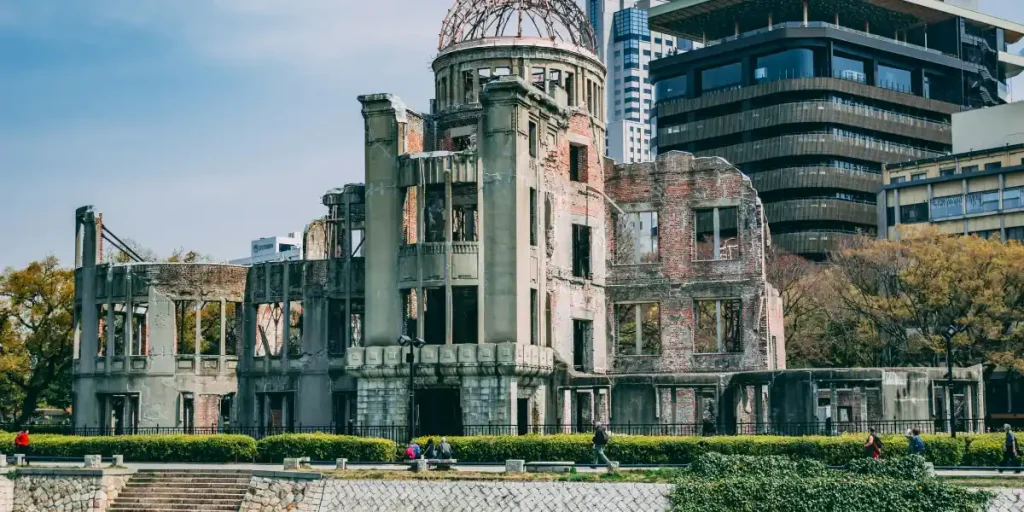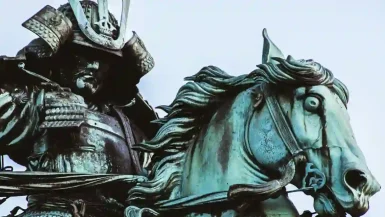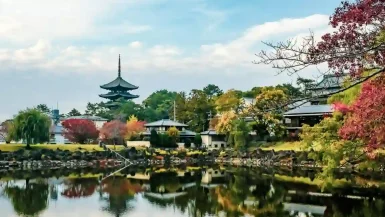Introduction
Hiroshima Peace Memorial Park and Museum is a poignant symbol of resilience and a testament to the human spirit. Located in Hiroshima, Japan, the park and museum commemorate the victims of the atomic bombing on August 6, 1945. This blog will take you on an in-depth exploration of the park and museum, highlighting their historical significance, key attractions, and the profound messages they convey.
The Historical Significance of Hiroshima Peace Memorial Park and Museum
The Events Leading to the Bombing
In the final stages of World War II, Hiroshima became the target of the first atomic bomb used in warfare. On that fateful day, August 6, 1945, the bomb, nicknamed “Little Boy,” was dropped, causing unprecedented destruction. The immediate explosion killed thousands, and the aftermath left the city in ruins. In addition to the immense loss of life, the bomb caused long-term radiation effects that impacted survivors for decades. Furthermore, the devastation of Hiroshima marked a turning point in history, leading to the eventual end of the war and the global recognition of the need for nuclear disarmament. Hiroshima stands today also as a symbol of peace and resilience.
The Creation of Hiroshima Peace Memorial Park and Museum
The idea to create Hiroshima Peace Memorial Park and Museum emerged shortly after the bombing. In 1949, Hiroshima City decided to build the park to honor the victims and promote peace. Architect Kenzo Tange designed the park, and it was officially opened in 1954. The museum was established to document the bombing’s impact and educate future generations.
Exploring Hiroshima Peace Memorial Park
The A-Bomb Dome: A Symbol of Devastation
The A-Bomb Dome, once the Hiroshima Prefectural Industrial Promotion Hall, stands as a stark reminder of the bombing’s devastation. Remarkably, it is one of the few structures that survived the explosion, preserving a powerful piece of history. Today, it is a UNESCO World Heritage site and a symbol of peace, drawing visitors from around the world. As you approach the Dome, you can feel the weight of the history it represents, making it a deeply moving experience. In addition to the Dome, the surrounding Hiroshima Peace Memorial Park offers a serene space for reflection and remembrance. Moreover, the park is home to several other memorials and monuments dedicated to the victims of the bombing.
For a more comprehensive understanding, visit the Hiroshima Peace Memorial Museum, which provides detailed exhibits on the events of August 6, 1945. Additionally, the museum highlights the stories of survivors, adding a personal perspective to the tragedy. As you leave the site, you carry with you a profound message of the importance of peace and the resilience of the human spirit. Ultimately, the A-Bomb Dome and its surroundings serve as a poignant reminder of the past, while inspiring hope for a more peaceful future.
The Children’s Peace Monument: Honoring Young Lives
The Children’s Peace Monument is dedicated to the memory of Sadako Sasaki and the thousands of children who perished. Sadako, a young girl who developed leukemia from radiation exposure, folded over a thousand paper cranes in hope of recovery. Her story inspired this monument, where visitors often leave paper cranes as a tribute.

The Cenotaph for the A-Bomb Victims: A Solemn Memorial
The Cenotaph for the A-Bomb Victims is a curved stone structure that holds the names of those who died. Inscribed with the words, “Rest in Peace, for the error shall not be repeated,” it serves as a solemn reminder of the tragedy and a call for peace.
The Peace Bell: A Call for Global Harmony
The Peace Bell, located near the A-Bomb Dome, invites visitors to ring it as a gesture of peace. The bell features a world map without borders, symbolizing a unified world. Its resonant sound serves as a call for global harmony.
The Flame of Peace: An Eternal Vigil
The Flame of Peace burns continuously in Hiroshima Peace Memorial Park. It stands as a powerful symbol of the hope for a world free of nuclear weapons. Notably, the flame will remain lit until all nuclear weapons are abolished, reflecting a global commitment to peace. As you walk through the park, the flame serves as a constant reminder of the devastation caused by nuclear warfare and the collective responsibility to prevent it from happening again. In addition to its symbolic significance, the flame connects visitors with the park’s broader message of peace and reconciliation. Moreover, it encourages reflection on the importance of disarmament and the need for ongoing efforts to achieve it.
Many visitors find the sight of the flame deeply moving, as it underscores the ongoing struggle for a safer, more peaceful world. In conjunction with other memorials in the park, the Flame of Peace creates a powerful narrative of hope and determination. Ultimately, it serves not just as a memorial, but as a call to action for future generations to work toward a world free from the threat of nuclear weapons. As you leave the park, the image of the flame lingers, reminding you of the importance of continuing the pursuit of peace.
Inside Hiroshima Peace Memorial Museum
The Main Building: Documenting the Horror
The main building of Hiroshima Peace Memorial Museum offers a detailed account of the bombing. As you explore the exhibits, you will encounter artifacts, photographs, and personal stories of survivors that bring the tragedy to life. Each display conveys the horror of the event and the unimaginable suffering endured by the victims. For instance, the museum showcases items such as tattered clothing and melted objects, which illustrate the intense heat and destruction caused by the blast. In addition to these artifacts, there are heart-wrenching testimonials from survivors, offering firsthand accounts of their experiences on that fateful day. These stories provide a deeply personal perspective, making the historical event more tangible and relatable. Moreover, the museum does not shy away from the broader implications of the bombing, addressing the long-term effects on the survivors, known as hibakusha.
Through these powerful exhibits, visitors gain a profound understanding of the human cost of nuclear warfare. Finally, as you move through the museum, the narrative shifts from the past to the present, emphasizing the ongoing need for peace and the global effort to prevent such tragedies from happening again. Ultimately, the Hiroshima Peace Memorial Museum serves as a stark reminder of the horrors of war and the enduring importance of peace.
The East Building: Educating Future Generations
The East Building focuses on educating visitors about the atomic bombing and its aftermath. Within this space, you’ll find interactive exhibits, videos, and models that explain the science behind the bomb and its devastating effects. These resources offer a comprehensive understanding of the event, breaking down complex scientific concepts into accessible information. For example, one exhibit demonstrates the chain reaction that led to the bomb’s explosion, helping visitors grasp the destructive power unleashed on Hiroshima. In addition to the scientific explanations, the East Building also delves into the immediate and long-term effects of the bombing on the city’s population.
By exploring these exhibits, you gain insight into the physical and psychological toll on the survivors, as well as the environmental impact on Hiroshima. Furthermore, the building emphasizes the global implications of nuclear weapons, encouraging visitors to consider their role in promoting peace. The goal of these exhibits is not only to inform but also to inspire future generations to work towards a world free of nuclear threats. As you engage with the interactive elements, you are reminded of the importance of education in fostering a more peaceful world. Ultimately, the East Building serves as a powerful educational tool, urging visitors to reflect on the past while actively contributing to a more peaceful future.
Survivor Testimonies: Voices of Resilience
One of the most impactful aspects of Hiroshima Peace Memorial Museum is the survivor testimonies. Known as hibakusha, these survivors share their personal experiences of the bombing. Their stories are a powerful testament to human resilience and the need for a nuclear-free world.
Artifacts and Exhibits: Tangible Reminders
The museum houses numerous artifacts that survived the bombing. Items like charred clothing, melted glass, and scorched everyday objects serve as tangible reminders of the tragedy. These artifacts humanize the historical event, making it more relatable and impactful.
The Message of Hiroshima Peace Memorial Park and Museum
Promoting Peace and Reconciliation
Hiroshima Peace Memorial Park and Museum are not just about remembering the past. They actively promote peace and reconciliation. Through various programs, exhibitions, and events, they encourage dialogue and understanding among people from different backgrounds.
Advocating for Nuclear Disarmament
A core message of Hiroshima Peace Memorial Park and Museum is the advocacy for nuclear disarmament. The exhibits and educational programs emphasize the catastrophic consequences of nuclear weapons. The goal is to inspire a global movement towards the abolition of these weapons.
Educating Future Generations
The museum plays a crucial role in educating future generations about the horrors of nuclear warfare. School groups, tourists, and international delegations visit the museum to learn about the bombing. This education aims to prevent the recurrence of such a tragedy.
Honoring the Victims
Hiroshima Peace Memorial Park and Museum honor the memory of those who perished in the bombing. Each monument and exhibit is a tribute to the victims. By remembering their suffering, we are reminded of the importance of peace and the value of human life.
Visiting Hiroshima Peace Memorial Park and Museum: A Practical Guide
Getting There
Hiroshima Peace Memorial Park and Museum are easily accessible by public transportation. To begin your journey, from Hiroshima Station, you can take a streetcar to Genbaku Dome-mae Station. It is both convenient and affordable. Once you arrive at the station, the park is just a short walk away, making it easy to navigate even for first-time visitors. Alternatively, if you prefer a more direct route, taxis and buses are available, providing additional options for getting to the park. For those interested in a more leisurely approach, the streetcar ride itself offers a glimpse of the city’s daily life, adding to the overall experience. Moreover, the well-marked signs and maps in the area ensure that you won’t have any trouble finding your way. In addition, if you’re staying in the city center, the park is within walking distance from many hotels, allowing you to explore at your own pace.
Furthermore, Hiroshima’s public transportation system is reliable and easy to use. It is making simple to incorporate a visit to the park into your itinerary. Before you head out, consider checking the local transit schedules to plan your visit efficiently. Ultimately, no matter which mode of transportation you choose, getting to Hiroshima Peace Memorial Park and Museum is straightforward and stress-free, ensuring a smooth start to your visit.
Admission and Opening Hours
The museum is open daily, except for December 30 and 31. The opening hours vary by season, so it is advisable to check the official website for up-to-date information. Admission fees are modest, with discounts available for students and groups.
Guided Tours and Audio Guides
Guided tours and audio guides are available for visitors. These resources provide valuable insights into the exhibits and the history of the bombing, enriching your understanding of Hiroshima’s past. For convenience, English-speaking guides are often available, and audio guides come in multiple languages, ensuring that international visitors can fully engage with the content. Additionally, the guided tours offer a more personalized experience, allowing you to ask questions and delve deeper into specific areas of interest.
Best Time to Visit
While the museum is impactful year-round, visiting during August can be particularly poignant. August 6th is the anniversary of the bombing, and the park hosts the Hiroshima Peace Memorial Ceremony. The event includes speeches, the release of doves, and the floating of lanterns on the river.
Nearby Attractions
Hiroshima offers several other attractions worth visiting. For history enthusiasts, Hiroshima Castle is a must-see. This beautiful reconstruction of the original castle provides a glimpse into Japan’s feudal past. As you explore the castle grounds, you can learn about the samurai who once lived there and enjoy panoramic views of the city from the top floor. In addition to the castle, Shukkeien Garden is another highlight, offering scenic landscapes that are perfect for a peaceful stroll. The garden’s winding paths, picturesque bridges, and carefully curated plants create a serene atmosphere, ideal for relaxation.
Moreover, if you’re looking to explore further, Miyajima Island is just a short ferry ride away. This island is famous for its iconic floating torii gate. It’s providing a stunning photo opportunity. On the island, you can also visit Itsukushima Shrine, a UNESCO World Heritage site known for its unique architecture. As you walk through the island’s natural beauty, you’ll encounter friendly deer that roam freely, adding to the charm of the experience. For those with more time, hiking up Mount Misen offers breathtaking views of the surrounding sea and islands. Ultimately, Hiroshima’s diverse attractions ensure that there is something for everyone, whether you’re interested in history, nature, or simply enjoying the city’s tranquil spaces.
Conclusion
Hiroshima Peace Memorial Park and Museum stand as powerful symbols of hope, resilience, and the quest for peace. They serve as a stark reminder of the horrors of nuclear warfare while promoting a message of global harmony and nuclear disarmament. Visiting Hiroshima Peace Memorial Park and Museum is a profound and moving experience, offering valuable lessons for all of humanity.
By exploring the park and museum, we not only honor the memory of the victims but also commit ourselves to a future free of nuclear weapons. Let us remember the past, learn from it, and work together towards a peaceful and harmonious world. Plan your visit to Hiroshima Peace Memorial Park and Museum and immerse yourself in a journey through history and hope.



